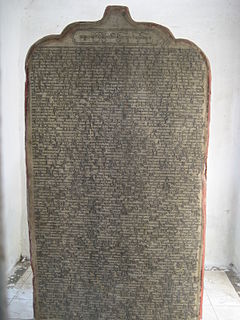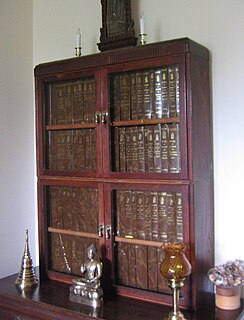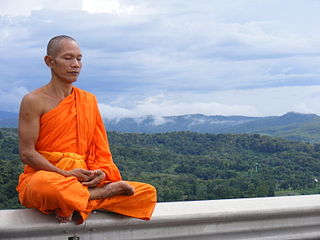
Sangha is a Sanskrit word used in many Indian languages, including Pali, meaning "association", "assembly", "company" or "community". It was historically used in a political context to denote a governing assembly in a republic or a kingdom. It is used in modern times by groups such as the political party and social movement Rashtriya Seva Sangh. It has long been commonly used by religious associations including by Jains and Sikhs.

The Vinaya is the regulatory framework for the sangha or monastic community of Buddhism based on the canonical texts called the Vinaya Pitaka. The teachings of the Gautama Buddha can be divided into two broad categories: Dharma "doctrine" and Vinaya "discipline".

Buddhist texts were initially passed on orally by monks, but were later written down and composed as manuscripts in various Indo-Aryan languages which were then translated into other local languages as Buddhism spread. They can be categorized in a number of ways. The Western terms "scripture" and "canonical" are applied to Buddhism in inconsistent ways by Western scholars: for example, one authority refers to "scriptures and other canonical texts", while another says that scriptures can be categorized into canonical, commentarial and pseudo-canonical. Buddhist traditions have generally divided these texts with their own categories and divisions, such as that between buddhavacana "word of the Buddha," many of which are known as "sutras," and other texts, such as shastras (treatises) or Abhidharma.
The Sutta Pitaka is the second of the three divisions of the Tripitaka or Pali Canon, the Pali collection of Buddhist writings of Theravada Buddhism. The Sutta Pitaka contains more than 10,000 suttas (teachings) attributed to the Buddha or his close companions.

Since the death of the historical Buddha, Siddhartha Gautama, Buddhist monastic communities have periodically convened to settle doctrinal and disciplinary disputes and to revise and correct the contents of the sutras. These gatherings, referred to by historians as 'Buddhist councils', are recorded in the Buddhist sutras as having begun immediately following the death of the Buddha and have continued into the modern era.
The Abhidhamma Piṭaka is the last of the three pitakas constituting the Pali Canon, the scriptures of Theravāda Buddhism.

The Pratimokṣa is a list of rules governing the behaviour of Buddhist monastics. Prati means "towards" and mokṣa means "liberation" from cyclic existence (saṃsāra).
Pali literature is concerned mainly with Theravada Buddhism, of which Pali is the traditional language. The earliest and most important Pali literature constitutes the Pāli Canon, the scriptures of Theravada school.

A sāmaṇera (Pali); Sanskrit śrāmaṇera, is a novice male monastic in a Buddhist context. A female novice is a śrāmaṇerī or śrāmaṇerikā.
The term Early Buddhism can refer to two distinct periods, both of which are covered in a separate article:
Parivāra is the third and last book of the Theravādin Vinaya Pitaka. It includes a summary and multiple analyses of the various rules identified in the Vinaya Pitaka's first two books, the Suttavibhanga and the Khandhaka, primarily for didactic purposes. As it includes a long list of teachers in Ceylon, scholars, and even Theravada fundamentalists, recognize that, at least in its present form, it is of late date, some suggesting it may be even later than the Fourth Council in Ceylon in the last century BCE, at which the Pali Canon was written down from oral tradition.

The Eight Garudhammas are additional precepts required of bhikkhunis above and beyond the monastic rule (vinaya) that applied to monks. The authenticity of these rules is highly contested; they were supposedly added to the (bhikkhunis) Vinaya "to allow more acceptance" of a monastic Order for women, during the Buddha's time. They are controversial because they attempt to push women into an inferior role and because many Buddhists, especially Theravadin women, have found evidence that the eight Garudhammas are not really the teachings of Gautama Buddha.
The Tripiṭaka or Tipiṭaka, is the traditional term for the Buddhist scriptures. The version canonical to Theravada Buddhism is generally referred to in English as the Pali Canon. Mahayana Buddhism also holds the Tripiṭaka to be authoritative but, unlike Theravadins, it also includes in its canon various derivative literature and commentaries that were composed much later.

The Pāli Canon is the standard collection of scriptures in the Theravada Buddhist tradition, as preserved in the Pāli language. It is the most complete extant early Buddhist canon.
A bhikkhunī (Pali) or bhikṣuṇī (Sanskrit) is a fully ordained female monastic in Buddhism. Male monastics are called bhikkhus. Both bhikkhunis and bhikkhus live by the Vinaya, a set of rules. Until recently, the lineages of female monastics only remained in Mahayana Buddhism and thus are prevalent in countries such as China, Korea, Taiwan and Vietnam but a few women have taken the full monastic vows in the Theravada and Vajrayana schools over the last decade. From conservative perspectives, none of the contemporary bhikkuni ordinations are valid.
Early Buddhist Texts (EBTs) or Early Buddhist Literature refers to the parallel texts shared by the Early Buddhist schools, including the first four Pali Nikayas, some Vinaya material like the Patimokkhas of the different Buddhist schools as well as the Chinese Āgama literature. Besides the large collections in Pali and Chinese, there are also fragmentary collections of EBT materials in Sanskrit, Khotanese, Tibetan and Gāndhārī. The modern study of early pre-sectarian Buddhism often relies on comparative scholarship using these various early Buddhist sources.










